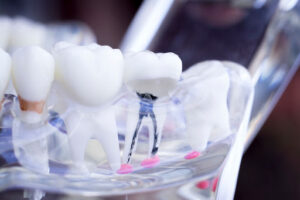 Tooth infections can progress quickly and become dangerous if left untreated. Early intervention with a root canal can be the most effective way to save your tooth and prevent complications. At Dr. Egger’s practice, you receive trusted care from a team focused on fast, effective relief and long-term oral health.
Tooth infections can progress quickly and become dangerous if left untreated. Early intervention with a root canal can be the most effective way to save your tooth and prevent complications. At Dr. Egger’s practice, you receive trusted care from a team focused on fast, effective relief and long-term oral health.
What Causes A Tooth Infection?
A tooth infection, also called a dental abscess, typically begins when bacteria enter the inner part of the tooth through untreated cavities, cracks, or gum disease. When this happens, the pulp inside the tooth becomes inflamed or infected. If not treated promptly, the infection can spread beyond the tooth into the surrounding tissues, leading to serious health risks.
Common Symptoms You Shouldn’t Ignore
You may first notice a tooth infection when pain begins in or around a specific tooth. This discomfort can be sharp, throbbing, or constant, and may worsen when you bite or chew. As the infection grows, you may experience symptoms such as:
-
Swelling in the gums, jaw, or face
-
Red, inflamed gum tissue
-
Sensitivity to hot or cold
-
A persistent bad taste or foul-smelling drainage
-
Fever, nausea, or swollen lymph nodes
-
Difficulty swallowing or breathing
These signs can indicate the infection is spreading and require immediate dental attention. Even if the pain subsides on its own, the infection may still be present and worsening beneath the surface.
Can Root Canal Therapy Save An Infected Tooth?
Yes, in many cases, a root canal can remove the infection and preserve your natural tooth. The key is early treatment. Root canals are most effective when performed before the infection causes irreversible damage. If the infection destroys the tooth’s structure or spreads too far, removal may be the only option.
Ignoring symptoms or delaying treatment can lead to a life-threatening condition. That’s why it’s essential to respond to early warning signs rather than waiting for more severe symptoms to appear.
Don’t Wait—Protect Your Health With Expert Care
If you suspect a tooth infection, don’t delay care. Early intervention can save your tooth and prevent the infection from spreading. Turn to Dr. Egger in Mount Pleasant, Michigan, for experienced and compassionate treatment. To schedule an appointment, call 989-773-3560 today. Your health and comfort are the top priority at Dr. Egger’s practice.

 When you develop a
When you develop a  If you’re experiencing ongoing tooth pain or sensitivity, your dentist may recommend a
If you’re experiencing ongoing tooth pain or sensitivity, your dentist may recommend a 





